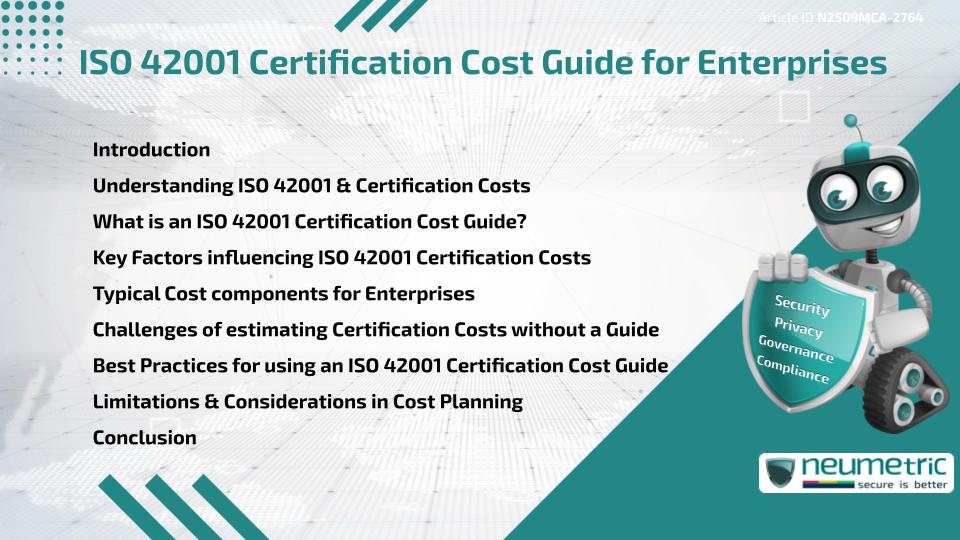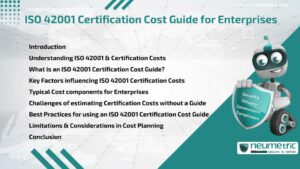Table of Contents
ToggleIntroduction
An ISO 42001 Certification Cost Guide provides Enterprises with clarity on the Expenses associated with achieving Certification. It helps Organisations anticipate costs such as Audits, Training, Consultancy & Internal Resources, ensuring informed Budgeting & Resource allocation. Without such guidance, Enterprises may face hidden costs, Budget overruns & inefficient use of Resources. This article explores the purpose, benefits, influencing factors, cost components & best practices of an ISO 42001 Certification Cost Guide for Enterprises.
Understanding ISO 42001 & Certification Costs
ISO 42001 is a globally recognised Standard that sets requirements for establishing & maintaining Compliance Systems. For Enterprises, Certification provides Credibility, enhances Client Trust & ensures Regulatory alignment. However, Certification requires Investment & Costs vary depending on organisational size, complexity & existing Compliance maturity. A structured guide helps Organisations prepare financially while reducing Risks of unexpected Expenses.
For more about ISO standards, see the International organisation for Standardisation.
What is an ISO 42001 Certification Cost Guide?
An ISO 42001 Certification Cost Guide is a structured reference that outlines all Expenses associated with Certification. It breaks down costs into categories such as external auditor fees, consultant charges, Training Programs & technology investments. By using the guide, Enterprises gain transparency into the Financial requirements of Certification & can plan accordingly.
Key Factors influencing ISO 42001 Certification Costs
The cost of Certification is influenced by several factors:
- Organisation size: Larger Enterprises require broader Audits & more Resources.
- Complexity of Operations: Multi-departmental or Global Firms face higher costs.
- Current Compliance maturity: Enterprises with existing Compliance frameworks may incur lower Expenses.
- Consultancy support: Engaging external Consultants adds to costs but can improve efficiency.
- Technology adoption: Using Audit readiness Tools or Compliance Software may involve upfront Costs but reduce long-term Expenses.
Typical Cost components for Enterprises
An ISO 42001 Certification Cost Guide typically includes:
- Gap Analysis: Fees for identifying Compliance gaps.
- Training: Costs of educating Staff on ISO 42001 requirements.
- Consultancy: Charges for External Experts supporting implementation.
- Internal Resources: Time & effort of Employees managing Compliance.
- Certification Audits: Fees paid to accredited Certification Bodies.
- Technology & Tools: Expenses for Compliance Software & Monitoring Systems.
- Maintenance costs: Ongoing Surveillance Audits & Recertification Fees.
Challenges of estimating Certification Costs without a Guide
Enterprises without an ISO 42001 Certification Cost Guide may face:
- Underestimation of hidden costs
- Poor allocation of Resources
- Delays in Certification due to Budget shortfalls
- Inconsistent cost comparisons across Departments
- Difficulty in securing Management approval for Budgets
These challenges can undermine both Financial planning & Certification readiness.
Best Practices for using an ISO 42001 Certification Cost Guide
To maximise value, Enterprises should:
- Conduct a preliminary Gap Analysis before Budgeting
- Involve Finance Teams in cost planning
- Compare multiple Certification Bodies for Audit fees
- Allocate Contingency Funds for unexpected Expenses
- Review & update Budgets regularly as the Certification Process progresses
Limitations & Considerations in Cost Planning
While an ISO 42001 Certification Cost Guide provides transparency, it cannot guarantee exact figures. Costs vary by region, Industry & Auditor selection. Additionally, reliance solely on cost figures may cause Enterprises to overlook the strategic benefits of Certification, such as enhanced Trust & Market competitiveness. The guide should therefore be used as a planning tool rather than a rigid Budget.
Conclusion
An ISO 42001 Certification Cost Guide helps Enterprises Plan & manage the Financial aspects of Certification. By identifying cost components & influencing factors, Enterprises can Budget effectively, avoid unexpected Expenses & achieve Certification more smoothly.
Takeaways
- An ISO 42001 Certification Cost Guide outlines Expenses linked to Certification.
- Key factors influencing Costs include size, complexity, maturity & Technology use.
- Typical components include Gap Analysis, Training, Consultancy & Audits.
- Without a guide, Enterprises Risk hidden costs & poor Budgeting.
- Best Practices include early Analysis, Finance involvement & Contingency planning.
FAQ
What is an ISO 42001 Certification Cost Guide?
It is a structured reference that outlines Expenses linked to achieving ISO 42001 Certification.
Why do Enterprises need a Certification Cost Guide?
It helps in Planning, Budgeting & avoiding unexpected Expenses during Certification.
What factors influence Certification Costs?
Factors include Enterprise size, complexity, current Compliance maturity, Consultant use & Technology adoption.
What are typical Cost components?
They include Training, Audits, Consultancy, Gap Analysis, Technology & Maintenance.
Can Certification be achieved without External Consultants?
Yes, but Consultants often provide efficiency & Expertise that reduce Risks of Non-Compliance.
How much do Certification Audits usually Cost?
Costs vary widely depending on Auditor, Region & Enterprise size, so Enterprises must request specific quotes.
Do Enterprises need to Budget for ongoing Costs?
Yes, Surveillance Audits, Staff Training & Recertification involve recurring Expenses.
Need help for Security, Privacy, Governance & VAPT?
Neumetric provides organisations the necessary help to achieve their Cybersecurity, Compliance, Governance, Privacy, Certifications & Pentesting needs.
Organisations & Businesses, specifically those which provide SaaS & AI Solutions in the Fintech, BFSI & other regulated sectors, usually need a Cybersecurity Partner for meeting & maintaining the ongoing Security & Privacy needs & requirements of their Enterprise Clients & Privacy conscious Customers.
SOC 2, ISO 27001, ISO 42001, NIST, HIPAA, HECVAT, EU GDPR are some of the Frameworks that are served by Fusion – a SaaS, multimodular, multitenant, centralised, automated, Cybersecurity & Compliance Management system.
Neumetric also provides Expert Services for technical security which covers VAPT for Web Applications, APIs, iOS & Android Mobile Apps, Security Testing for AWS & other Cloud Environments & Cloud Infrastructure & other similar scopes.
Reach out to us by Email or filling out the Contact Form…





